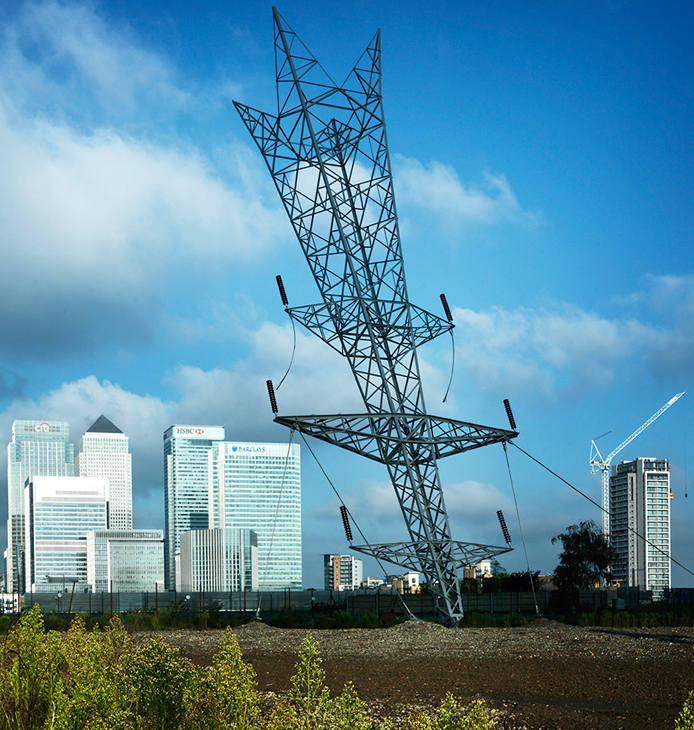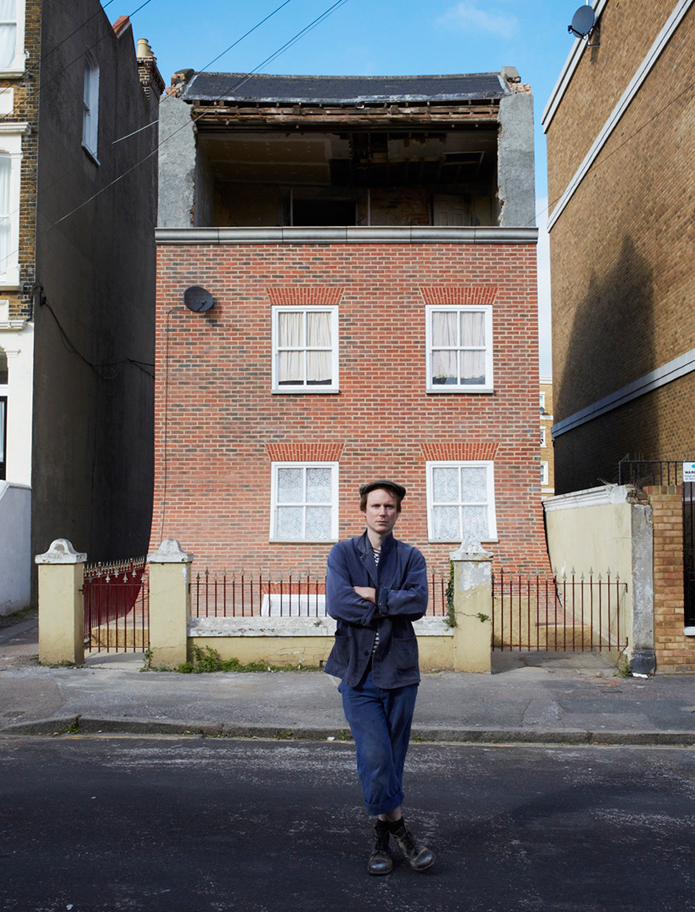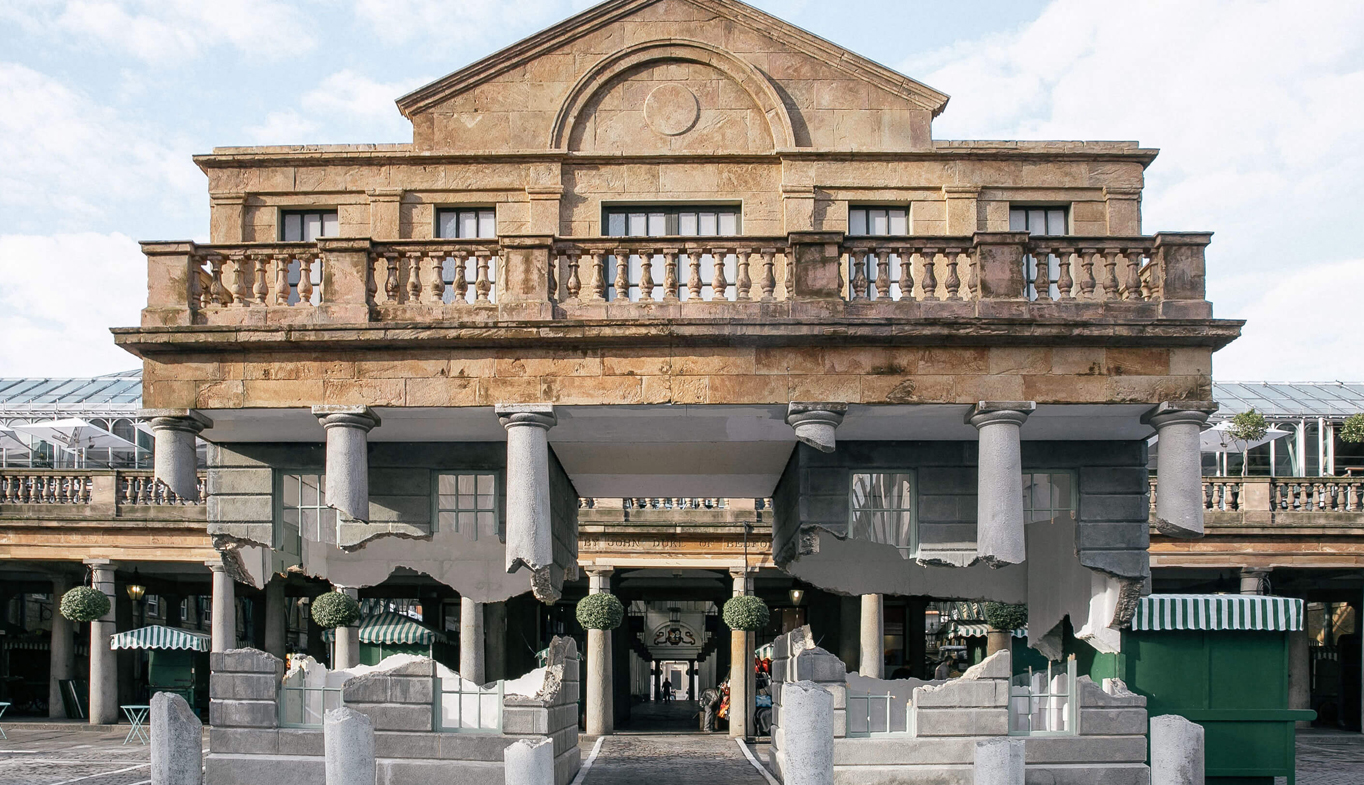The title of ‘a creator’ – simply defined ‘as a person that brings something into existence’ – is perhaps paying an injustice to Alex Chinneck. For he is no ordinary ‘creator’. As the British sculptor and Chelsea College of Art graduate has pushed the boundaries of possibility further than most artists ever have – or ever will.
Part of the reason why he’s able to create the boundary-pushing, awe-inspiring work is his passion. The buildings that float in mid-air, melt into the ground or turn upside down do not transpire out of thin air – although ironically, they appear as if they do. His dedication to the craft and his penchant for risk-taking is evident to anyone who spends just a few minutes in his company. Whether he is speaking about his favourite material or the music that inspires his creativity, he’ll pause meaningfully. Then he’ll smile while passing through the trails of his imagination, before announcing his well-considered thoughts; in that exact order, every single time. That’s a pleasure to watch – an artist who has seen certain projects welcome over one million visitors – remain a slave to his trade and his evolving ingenuity. OPUMO met with the Board Member of the Royal British Society of Sculptors in Hoi Polloi, one of his favourite London haunts, to talk inspiration, expectation and how the future looks for one of Britain’s most innovative artists.

To date, most of your work has not been permanent, why is that? Do you like the allure and mystery around temporary pieces?
For me, the most exciting responses are the ones that are not durable and the most exciting locations are the ones that do not allow permanent locations. Impermanence be it location or material gives you a greater license for ambition and exploration, but I’m increasingly interested in permanent work where design, durability, vandalism and maturity become major considerations. Trying to develop a dialogue with things that have been there forever is the major challenge. If you can strike up a dialogue, you can strike up a conversation with the people and then it stands the best possible chance of success.
On the topic of dialogue, how do you react to people’s reactions towards your work?
Typically, once an artwork is installed I move on. I don’t abandon the project but they are so large and there is so many concealed elements, that it’s just done. It’s when we’re developing the project, conceiving ideas, that’s when I never stop – forever talking to people about things. That’s the period. There’s this window of idea and conception and after that, it’s all just technical and administrational delivery. It’s really unglamorous, it’s really unbohemian. I crave being in a studio; but I’m in an office. I'd love to make a work in one day; but it takes one year. It’s part of the process, it’s part of my practice.
Who do you seek out as part of the creative process?
It’s difficult to say, but mainly manufacturers, engineers, my team, my girlfriend.
What sort of reaction are you looking for? A positive one, or do you work off of shock, or ones that say 'you’ll never be able to do that'?
Doubt is a driving force – it’s nice to prove people wrong. I think I’m far more driven by the notion of proving people wrong than proving people right. I’m of course looking for people to be excited and astounded but Sophie - who works in my office and runs the practice in a way - is hyper-honest and hyper-critical and she’s probably my most valuable critic. She shapes the outcome; she interrogates me more than other people and that’s a great exercise. My ego wants praise but my projects and their genuine development need critique.
How have you managed to evolve what you describe as your ‘creative process’? Is it something you have been working towards all your life?
When I was a child I used to draw a lot. Houses in particular. I used to draw houses a lot and clouds. I used to draw things how I wanted things to be and I used to get so annoyed when people would change the drawing or tell me things don’t look like that – that’s how I wanted it to look. I remember getting so pissed off about that actually. On reflection, yes there is a natural extension there but no, my parents don’t come from an artistic background or anything. They’re not in any way technical or interested in the art – and because of that there are times I think I don’t belong in this world, in this industry. But I also think that’s a real advantage. I don’t indulge in the mindset or that way of behaving – I just get on with it.
 A Bullet from a Shooting Star by Alex Chinneck[/caption]
[caption id="attachment_21615" align="alignnone" width="695"]
A Bullet from a Shooting Star by Alex Chinneck[/caption]
[caption id="attachment_21615" align="alignnone" width="695"] From the knees of my nose to the belly of my toes. Image - Jenny Lewis.[/caption]}
From the knees of my nose to the belly of my toes. Image - Jenny Lewis.[/caption]}
So you think that your childhood has provided you with greater freedom away from a specific artistic background or a particular way of thinking?
I think it allowed me to walk my own creative path. I mean, I went to art school, but I hated it. There were too many artists and the only thing it gave me was a complex. I was so relieved and liberated to leave – it just opened doors to me. I mean, I could immediately indulge in other worlds, in other interests. I’m talking about architecture, engineering and manufacturing – but at college it just felt like a parade. It didn’t feel like a place of progress; it just didn’t feel like it was about making art it felt like it was about being ‘artists’.
There was a creative pressure to produce a certain piece of work, to talk a certain way and build your calendar around events. I just thought; if everyone is doing the same thing, talking the same way, thinking the same way, making work for the same place, it might be a different city but it’s still a white box – it’s still a white wall. The work is automatically suffocated by its conceptual breadth. But that’s what I love about outdoor art and public art – every location is a new set of opportunities and challenges. It forces new conceptual responses every time. If I was creating work every week for galleries, I’d just run out of ways to respond to the same white walls. It’s good for business perhaps, but it is not good for the brain.
It’s interesting that you reference art as a business. Is that the toughest thing, balancing concept and money? Or does the hardest part remain the creative drive?
It’s about the marriage. I think my greatest accomplishment to date isn’t necessarily the creative response or the vision but the execution – it’s all about pulling these things off. We’re doing things that haven’t been done before, haven’t been seen before and often above budget as we push the extremes as far as they can go. And that has been very challenging. I mean, I’m all passion and no profit. That is really stressful but it’s so rewarding. It’s not about ego, it’s all about reaching new and innovative outcomes.
You talk about how your path was different to the regimented one set up after art school. But how was yours different, what did do after you left art school?
The first thing I did was visit lots of architecture practices and spend a lot of time there. After, I visited hundreds of manufacturing sectors in the UK – companies that continue to be collaborators and sponsors of the things I do today – just to learn and understand material possibilities. The education across those sectors, particularly construction and engineering, was just priceless. Suddenly I knew how things were made, what they could be made from and once you develop those foundations it’s about developing an artistic response to help those ideas grow naturally with more pleasurable and poetic licensing. That period of like four years, I did things, I took on old buildings and flats and lived in them for free. I turned toilets in factories into art studios and worked there for free – perhaps that is quite entrepreneurial looking back – but that’s how it all started.
When did the time come that you thought you were ready for your first project and how did the idea for that come about?
I was working with manufacturers making models – and when I say models these things were about six foot tall. I soon came to realise they would be far more impressive and enchanting if they were introduced into the public realm and into an architectural context. I used to find it so demoralising that you pour everything you had – money, time, passion, into these sculptures that only ten people will see. So I started working outdoors and that was a great way of overcoming that feeling. Instantly you can turn ten people into ten thousand or even ten million. It’s a win-win.
Sitting here today, how would you describe your work?
Above all, I consider myself an artist. I am not a sculptor – you know I think of sculptors as those who make bronze horses, but I consider artists to appreciate bronze horses. Artists appreciate the intelligence and technical difficulties involved in bronze horses but not their necessity in a contemporary environment. I think being an artist makes you feel contemporary and it puts you under pressure to be new and it gives you a creative freedom that other expressions don’t allow.
What has been your favourite piece of work to date?
It changes a lot. The nicest piece of work I’ve ever made was the identically smashed windows. That has a wonderful subtlety and it is kind of spectacular when you see it, when you find it. ‘The Sliding House’ is probably the most popular – a real Instagram moment you know – that was a real accomplishment to do as we had to raise all the resources to do that – including finding the house. That said, another one of my favourites is 'A Bullet from a Shooting Star’. I mean, that one is a slow burner but it’s one that is going to get more popular.
On the topic of 'A Bullet from a Shooting Star' - how did you conceive the idea and then manage to pull it off?
It took about nine months from design to delivery. A lot of people were involved, we had to do bomb surveys, sewer contamination surveys and everything. The foundations go twenty- five metres down, its thirty-seven metres tall, its 100 tons of concrete. To create that effect was very, very hard but it was all worth it, for sure.
You say you always favour risk and challenges; is that just a natural urge or is it simply just the way design is for you?
It just has to be that way. There is no progress without risk. There is nothing exciting without challenge. Risk is not good for me, it's not healthy, it makes me stressful and anxious but it is the only way. There’s no point in doing it otherwise, it sounds obvious and cliché but that’s part of the reason I couldn’t keep on making art. It just felt like I was making the same stuff and looking around the corner and seeing someone making the same thing –today I’m trying desperately trying to find my own voice.
You say you don’t pay attention to other people, but did someone give you one piece of advice along the way that has stuck with you or something you would relay to someone new?
In terms of wisdom and lessons learnt I can only think of one particular phrase – ‘only the paranoid survive’. It’s about working hard. It’s a very competitive place the art world and I am by no means in comfortable territory - and I do not deserve to be. But I’ve worked hard and I’ve made progress so I’m terrified that all the time and energy I’ve made for myself will be lost, so I increasingly try turn use paranoia effectively. You don’t learn lessons through repetition. Its only by doing something new that you learn; it’s tough but a genuine education. Everything has to represent risk. After all, that’s where the fun is.
Stay up to date with Alex’ latest news and work by checking out his website and by following him on Instagram @alexchinneck.







